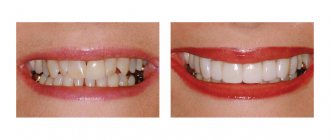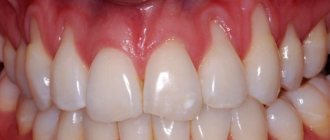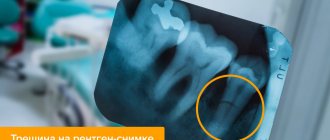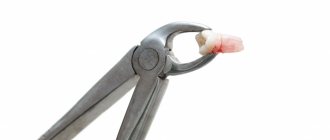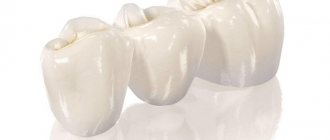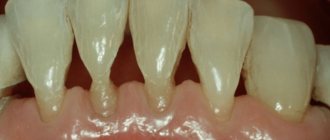Before
After
When there is no trace left of the dental crown, and all the roots are in place, a fair question arises: what to do next? Should this tooth be considered completely lost, or does the presence of the root provide a chance for restoration? Modern dentists, in the fight for every saved tooth, offer several options for solving this problem. The main thing is to make sure that the roots are healthy, there are no cysts, granulomas, inflammatory or carious formations on them.
The crown part of the front tooth is broken
If a front tooth is partially fractured, veneers or crowns can be used.
Veneers restore tooth function, protect dentin from external influences, and also the aesthetics of a smile. Treatment is only suitable for slightly damaged teeth. If the dental crown is severely damaged, the dentist will suggest installing a ceramic crown.
Crowns are placed on the remaining part of the tooth after grinding and preparing the surrounding area around the damaged tooth. If a significant part of the tooth has broken off, then to securely fix the crown it will be necessary to make a stump inlay, and in this case the tooth will have to be depulped (remove the nerve and fill the root canal).
The main stages of tooth restoration using a crown:
- Drawing up and agreeing on a treatment plan;
- Next, the doctor grinds the tooth down for a crown;
- Taking a silicone impression. The impression is sent to the dental laboratory. Based on the impression, the technicians reconstruct a plaster model of the teeth, and the technician will model the crown on it;
- When the crown is made, it is tried on and, if there is no discomfort, fixed on the stump.
To close the aesthetic defect, until the permanent crown is made, I install temporary plastic crowns on the patient, which can be made either in the laboratory or in the clinic.
Material for making dental crowns .
Front teeth are a person’s calling card. When smiling, in conversation, every person involuntarily exposes his front teeth. Their beauty and health attract their interlocutor. This is why choosing the type of crown for teeth in the smile area is so important. The main types of permanent dental crowns are metal-ceramics, metal-free ceramics and ceramics with a zirconium dioxide frame. The most preferable material, from an aesthetic point of view, for the manufacture of dental crowns for the front teeth is metal-free ceramics e.max or feldspathic ceramics, also ceramics with a zirconium dioxide frame.
What to do if only the root remains of the tooth?
Very often, dentists are faced with a situation where, due to some reason - be it caries, a short crown or an accident, only part of the tooth remains, namely the root. The other part is lost or eaten. The question arises: “What to do with such a tooth?”
If you want to save the root, then the following information will be useful to you.
First, an x-ray is taken to determine whether everything is normal in the root itself and the bone surrounding it, and if there is inflammation, destruction, cysts and granulomas. If everything is fine, then there are as many as eight options for tooth extension.
Moreover, these are options only for extension, and not for final cosmetic restoration, since first the root is restored and only then its cosmetic extension occurs. If the tooth needs to be preserved for a long time, it is necessary to use good light-curing materials, or prosthetics with a crown.
In the latter case, it is rational to save on a filling - not to put the best one - after all, no one except the dentist will see it under the crown. And you can choose a material that, most importantly, is hard, not afraid of moisture and has good adhesion to the root.
Each case is, of course, unique in its own way. And the choice of material will be influenced by many nuances: the degree of tooth destruction; type of reinforcing material; the state of the antagonist and occlusion, the level of the root edge - below the gingival edge or above; and even the doctor’s predilection for a particular manufacturer.
Recovery
If you simply put a filling on the root, it will please you for some time, but this time will be too short. She won't stand for long. We'll have to do something to strengthen the filling and create an additional connection with the root. What kind of connection are we talking about? About the chemical one, which is designed to glue the filling to the tooth, and about the physical one, which will hold the root and the filling together.
The simplest and fastest are anchor pins made of a special alloy that do not corrode. There are 20 varieties of them, differing in length and diameter, which allows you to choose the one you need for most cases.
These pins are fixed to a combined material that is specially designed for these purposes, has good adhesion to dental tissues and does not dissolve in a humid environment.
The restoration procedure with such pins is carried out in one visit. If the root canal is sealed, it is first expanded with special instruments to the required diameter, then fixed.
Non-metallic pins are also used for root restoration, the so-called fiberglass ones, which also differ in size. The advantage of fiberglass pins is that they are metal-free and do not have any chemical interaction with saliva or crowns and bridges. If you plan to restore a tooth without a crown with a light-curing material, then these pins are preferable to metal ones because of the color and good adhesion of the pin to the filling material. Fiberglass posts are believed to reduce the likelihood of root fracture of the restored tooth.
When the root canal is large in diameter, preference for its restoration is given to stump pin inlays. The doctor either models it directly on the root, or takes an impression, from which the technician makes an inlay from metal, special, of course. And the doctor the next day strengthens it to the root.
What to do when there is not one or even two, but three roots, and the tooth is severely damaged? Then anchor pins or a cast collapsible tab are used. Why collapsible? Since the roots and, accordingly, their channels are not parallel to each other, it is impossible to insert a ready-made tab into them. Therefore, one pin of such a cast tab is made separately from it itself. First the tab is inserted. Through it, this pin is inserted into the remaining root into a specially prepared hole. This option will serve “forever” and will leave the patient only when this tooth is removed.
Restoration method – bridge prosthesis
Dental bridges got their name for their visual resemblance to a bridge - they are a structure of two crowns, between which artificial teeth are located.
Crowns are placed on your own ground teeth. The advantages of bridges are good aesthetics and reliable fixation. Dental bridges are permanent, making them very comfortable. This type of dental prosthetics requires several visits to the doctor. First, impressions are made, from which a temporary prosthesis is made in a denture laboratory or clinic - the patient will not experience discomfort when communicating due to the absence of a front tooth. At the same time, the dental clinic prepares the supporting teeth. They are ground to install a crown to a shape that is optimally suitable for this, and most often (but not always) they are depulped. After the grinding is completed, impressions are taken again, from which dentists make a permanent prosthesis, and after that it is installed on the supporting teeth and fixed with cement.
The main disadvantage of a bridge is the need for depulpation and grinding of healthy supporting teeth. In addition, its installation, which leads to an uneven load on the alveolar bone and its thinning in the area of the missing tooth..
Filling or crown
To make a choice between a filling and a crown, you need to consider several factors:
- cavity size, degree of hard tissue weakening
- cavity shape
- forecast of restoration durability (filling + tooth construction)
It must be remembered that secondary caries develops under the filling; with a large volume of restoration, there is a risk of fracture of weakened hard tissues. Therefore, the only advantage of a filling over a crown is its low price and speed of production. But if you take into account that in a few years you will have to change the filling, it becomes clear that in the end such a restoration will only cost more.
Restoration method - one-stage implantation immediately after root removal
Single-stage implantation of a front tooth involves immediately installing an implant into the socket after tooth extraction. For this type of implantation, special dental implants with aggressive threading and a high degree of primary stabilization are used. On the same day, immediately after implantation, a temporary plastic crown is installed. This implantation allows you to solve two problems - removing a broken tooth root and closing a cosmetic defect. In addition, the method allows you to save a little, because... Some manipulations are not performed (for example, the gum former is not installed).
After 3-4 months, when osseointegration of the implant is complete, permanent crowns are installed. Just as in the case of conventional crowns, from an aesthetic point of view, the best solution for the front teeth is the use of ceramic crowns and, accordingly, abutments. It is preferable to install the crown on a zirconium dioxide abutment, then in any type of lighting the crown will not stand out from the general row of teeth. In our opinion, this option for restoring a broken front tooth is the most optimal.
Tooth restoration
It is important to understand that if there is the slightest opportunity to reconstruct a damaged tooth, it is necessary to take advantage of it. First of all, the specialist devotes all his efforts to restoring the root, and then to building up the crown. There are quite a lot of restoration methods; preference should be given to one or another option only on the basis of a preliminary examination of the patient’s oral cavity.
One of the options for tooth restoration is the use of a stump tab. It is installed in the root canal, after which prosthetics can begin. An important point: the tab can only be installed on an absolutely healthy root.
Build-up is a technology that involves strengthening the root system of a tooth using a pin. It can be made of fiberglass or metal. Its installation is possible only on the condition that the tooth root is not destroyed and there are no inflammatory processes in it. Experienced dentists work only with the most modern equipment and using hypoallergenic materials, so the results of their work are always excellent.
Cost of procedures
Prices for dental extensions vary depending on:
- Number of units restored.
- Severity of the defect.
- The chosen extension technique.
- Materials used.
The cost is also affected by the condition of the oral cavity, the preservation of the tooth root, the need for preliminary sanitation and other procedures. The final price of services is determined after examination by the dentist. The patient can influence the final cost by choosing more affordable composites and restoration technologies.
Regardless of the chosen technique, the doctors at the Ulybka dental clinic guarantee their patients beautiful and long-lasting results. Our specialists have extensive experience in building extensions of varying complexity, have modern tools and use advanced materials to ensure a highly aesthetic result.
You can find out the cost of extension of front and back teeth in Yoshkar-Ola in our price list.
Treatment
To restore a crumbled tooth root, an X-ray examination is first performed to determine the extent of the damage. Based on its results, the dentist decides on the choice of method of restoration of the dental unit.
- Single-rooted teeth with a broken root must be removed. It is impossible to save them. In addition, there is a high risk of developing an inflammatory process.
- Multi-rooted teeth with crumbled roots can be restored. In such cases, hemisection and other tooth-preserving operations are performed. They allow you to remove only the damaged element, while preserving the viable ones. The remaining roots will be used in the future as a support when installing a microprosthesis.
If it is impossible to save the tooth with a crumbled root, it is removed. To replace the aesthetic defect and restore chewing function, implantation is performed or a prosthesis is installed. The choice of the appropriate dental treatment option depends on the patient’s age, structural features of the dental system, the presence of chronic diseases, etc.
Indications and contraindications for the procedure
Extension is indicated in the following cases:
- Chips and cracks on the tooth surface.
- Destruction of enamel or its discoloration, which cannot be eliminated with bleaching.
- Partial tooth loss due to injury or caries.
- Malocclusion.
- Interdental gaps.
- Age-related wear of enamel, in which the dental unit darkens and becomes sensitive to external influences.
However, restoration is not suitable for every patient. It cannot be performed if one of the contraindications is present:
- Untreated caries or gum disease.
- Severe systemic diseases, such as blood diseases or diabetes.
- Some mental disorders.
- Bruxism.
- Bruxism. Individual intolerance to the components of the filling composite.
There are also technological limitations: if it is impossible to protect the restored surface from contact with moisture (for example, saliva), then the extension will have to be abandoned - the filling will not harden. Also, some methods cannot be used for dental treatment in children - for example, they do not have pins installed. For most patients, augmentation remains the optimal solution for restoring a lost tooth fragment.
Should I remove the root or not?
The first thing a patient with a broken tooth is asked to do in the clinic is to undergo an x-ray examination. Thanks to him, it will be possible to understand what condition the root is in and whether it is possible to preserve it. You can assume that we are talking about a root fracture based on such signs as bleeding from under the gums, the inability to connect teeth due to severe pain, obvious swelling of the gums or discoloration. If the root is broken, it must be removed.
In the case where the upper part of the tooth is broken, but the root remains intact, restoration can be carried out by installing an anchor or fiberglass pin. It is inserted into the root canal and serves as the basis for the subsequent application of layers of composite material. The advantages of this method include speed of implementation and minimal cost. The disadvantages are insufficient strength (excessive loads are contraindicated for a pinned tooth), and a shorter service life compared to implantation - about 3-5 years.
Clinical picture
Symptoms of damaged tooth roots depend on the condition of the pulp and the degree of displacement of fragments. A problem is indicated by:
- pain that intensifies when the upper and lower jaws are closed,
- swelling of soft tissues,
- redness and soreness of the mucous membrane in the damaged area,
- discoloration of the crown part of the tooth in a pinkish color due to internal hemorrhage.
If the root of a tooth with weak walls crumbles after a dental procedure, the doctor will notice this immediately and take measures to solve the problem.
Teeth extension using composite materials
Modern filling materials used for the restoration of front teeth harden only under the influence of the rays of a special lamp, most often an ultraviolet one. This gives the specialist the opportunity to carefully restore the natural shape of the damaged tooth. This is especially important when reconstructing large chips. However, after curing, the composite material becomes no less durable than a natural tooth, and if the doctor follows all standards and protocols, the junction of the enamel and the composite will not only be invisible, but also reliable - the tooth restored in this way will last for many years. However, it should be remembered that such restorations still have a service life and after 7 to 10 years they may require replacement.
Causes of root damage
The root of a tooth can crumble under the influence of several factors. The most common reasons for damage are:
- injuries,
- inaccurate expansion of root canals, their careless mechanical processing in preparation for filling,
- violation of pin implantation technology,
- uneven distribution of chewing load after installation of the prosthesis,
- complex tooth extraction.
The root can crumble if damaging pressure is transmitted parallel or perpendicular to its longitudinal axis. The most serious damage occurs from impacts and falls from heights.
Crown for a living tooth
When to place a crown on a living tooth
Stages of installing a crown on a living tooth
Types of crowns. Their pros and cons
When does pulp need to be removed?
Myths about dental crowns
The question of whether it is possible to put a crown on a living tooth has gathered many myths and prejudices and divided people into two camps. When you can put a crown on a living tooth, and when not, what are the pros and cons of both methods, we will consider in this article.
First, let's figure out what a living tooth means. A tooth is an organ consisting of a protective layer (enamel, dentin, cement) and a neurovascular bundle (pulp). A tooth is considered alive if the pulp is preserved, and dead if the pulp is removed - this procedure is usually carried out in the treatment of pulpitis and periodontitis.

